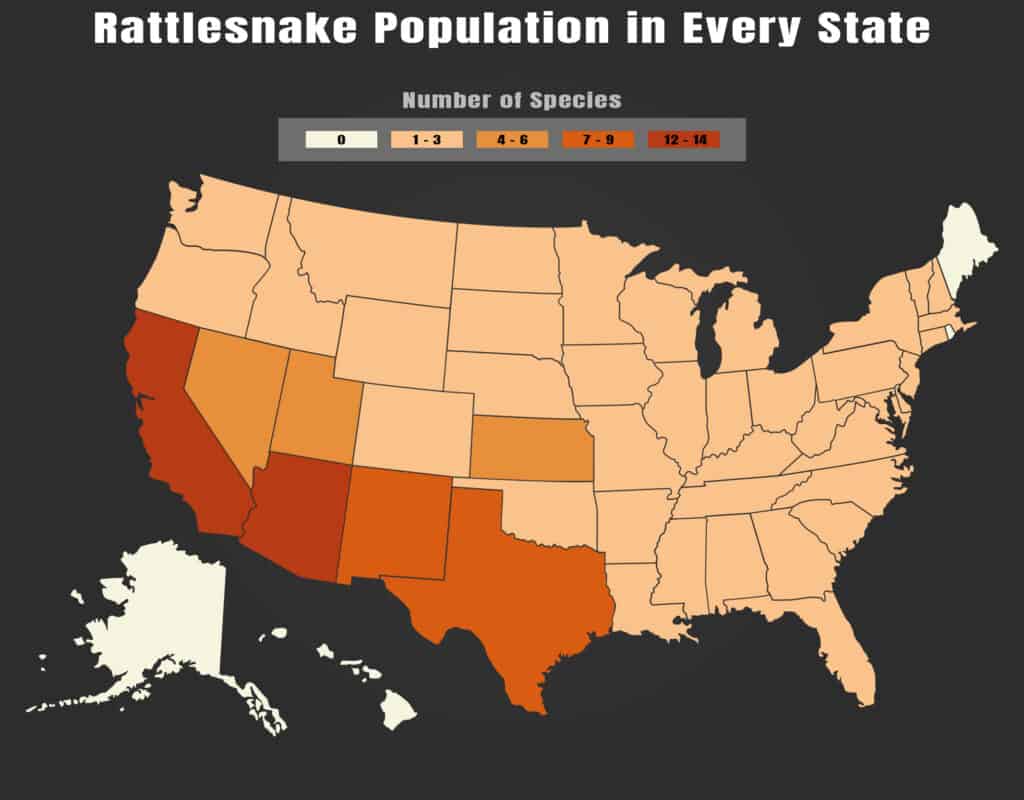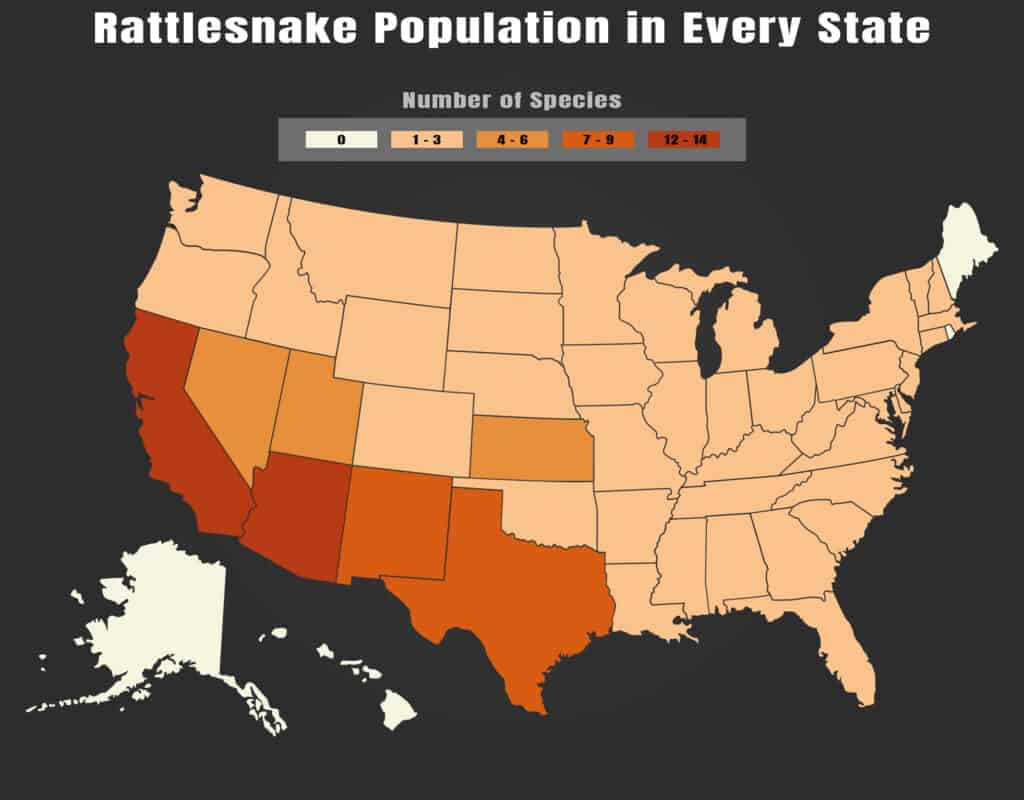Rattlesnakes, one of the most venomous snakes in North America, can be found in many states throughout the country. These reptiles have become renowned for their unique rattle, which warns predators of their presence. But which states do these slithery creatures call home?
From the deserts of the Southwest to the forests of the East Coast, rattlesnakes are widespread across the United States. Their habitat ranges from arid rocky terrain to lush wetlands, making them adaptable to a variety of environments. So, if you’re curious about which states are home to these fascinating serpents, read on to find out!
Rattlesnakes can be found in 33 states in the US, including Arizona, Texas, and California. These venomous snakes prefer dry and rocky habitats and are known for their distinctive rattle on the end of their tail, which they use as a warning signal. If you live in an area where rattlesnakes are present, it’s important to be aware of their behavior and take precautions to avoid getting bitten.

What States Have Rattlesnakes?
Rattlesnakes are venomous snakes that can be found in various parts of the United States. These snakes are known for their distinctive rattle on the end of their tail, which they use to warn potential predators. In this article, we will take a closer look at which states have rattlesnakes and what you need to know about them.
1. Arizona
Arizona is home to 13 different species of rattlesnakes, making it one of the most rattlesnake-rich states in the US. The most common species found in Arizona are the western diamondback rattlesnake and the Mojave rattlesnake. These snakes can be found in various habitats such as deserts, grasslands, and woodlands.
If you live in Arizona, it is important to be aware of the potential danger of rattlesnakes. You should always be cautious when hiking, camping, or spending time in areas where rattlesnakes are known to live. If you come across a rattlesnake, it is best to keep your distance and give it plenty of space.
2. Texas
Texas is another state that is well-known for its rattlesnakes. There are over 10 different species of rattlesnakes that can be found in Texas, including the western diamondback, timber rattlesnake, and the massasauga rattlesnake.
If you live in Texas, it is important to be aware of the potential danger of rattlesnakes. You should always be cautious when hiking, camping, or spending time in areas where rattlesnakes are known to live. If you come across a rattlesnake, it is best to keep your distance and give it plenty of space.
3. California
California is home to a few different species of rattlesnakes, including the western diamondback, sidewinder, and the northern Pacific rattlesnake. These snakes can be found in various habitats such as deserts, grasslands, and woodlands.
If you live in California, it is important to be aware of the potential danger of rattlesnakes. You should always be cautious when hiking, camping, or spending time in areas where rattlesnakes are known to live. If you come across a rattlesnake, it is best to keep your distance and give it plenty of space.
4. New Mexico
New Mexico is home to several species of rattlesnakes, including the western diamondback, prairie rattlesnake, and the massasauga rattlesnake. These snakes can be found in various habitats such as deserts, grasslands, and woodlands.
If you live in New Mexico, it is important to be aware of the potential danger of rattlesnakes. You should always be cautious when hiking, camping, or spending time in areas where rattlesnakes are known to live. If you come across a rattlesnake, it is best to keep your distance and give it plenty of space.
5. Colorado
Colorado is home to several species of rattlesnakes, including the western diamondback, prairie rattlesnake, and the massasauga rattlesnake. These snakes can be found in various habitats such as deserts, grasslands, and woodlands.
If you live in Colorado, it is important to be aware of the potential danger of rattlesnakes. You should always be cautious when hiking, camping, or spending time in areas where rattlesnakes are known to live. If you come across a rattlesnake, it is best to keep your distance and give it plenty of space.
6. Oklahoma
Oklahoma is home to several species of rattlesnakes, including the western diamondback, timber rattlesnake, and the massasauga rattlesnake. These snakes can be found in various habitats such as deserts, grasslands, and woodlands.
If you live in Oklahoma, it is important to be aware of the potential danger of rattlesnakes. You should always be cautious when hiking, camping, or spending time in areas where rattlesnakes are known to live. If you come across a rattlesnake, it is best to keep your distance and give it plenty of space.
7. Nevada
Nevada is home to several species of rattlesnakes, including the western diamondback, sidewinder, and the northern Pacific rattlesnake. These snakes can be found in various habitats such as deserts, grasslands, and woodlands.
If you live in Nevada, it is important to be aware of the potential danger of rattlesnakes. You should always be cautious when hiking, camping, or spending time in areas where rattlesnakes are known to live. If you come across a rattlesnake, it is best to keep your distance and give it plenty of space.
8. Utah
Utah is home to several species of rattlesnakes, including the western diamondback, Mojave rattlesnake, and the Great Basin rattlesnake. These snakes can be found in various habitats such as deserts, grasslands, and woodlands.
If you live in Utah, it is important to be aware of the potential danger of rattlesnakes. You should always be cautious when hiking, camping, or spending time in areas where rattlesnakes are known to live. If you come across a rattlesnake, it is best to keep your distance and give it plenty of space.
9. Wyoming
Wyoming is home to several species of rattlesnakes, including the western diamondback, prairie rattlesnake, and the massasauga rattlesnake. These snakes can be found in various habitats such as deserts, grasslands, and woodlands.
If you live in Wyoming, it is important to be aware of the potential danger of rattlesnakes. You should always be cautious when hiking, camping, or spending time in areas where rattlesnakes are known to live. If you come across a rattlesnake, it is best to keep your distance and give it plenty of space.
10. Florida
Florida is home to several species of rattlesnakes, including the eastern diamondback and the timber rattlesnake. These snakes can be found in various habitats such as swamps, marshes, and forests.
If you live in Florida, it is important to be aware of the potential danger of rattlesnakes. You should always be cautious when hiking, camping, or spending time in areas where rattlesnakes are known to live. If you come across a rattlesnake, it is best to keep your distance and give it plenty of space.
In conclusion, rattlesnakes can be found in various parts of the United States. If you live in or plan to visit any of the states mentioned above, it is important to be aware of the potential danger of rattlesnakes and take precautions to avoid them. Remember to always be cautious when hiking, camping, or spending time in areas where rattlesnakes are known to live, and never approach or try to handle a rattlesnake.
Frequently Asked Questions
Do you want to know which states have rattlesnakes? Below are some frequently asked questions about rattlesnakes and the states where they can be found.
What are some common types of rattlesnakes found in the United States?
There are many types of rattlesnakes found in the United States, but some of the most common include the western diamondback rattlesnake, the timber rattlesnake, and the eastern diamondback rattlesnake. These species are found in different regions of the country but are all venomous and potentially dangerous to humans.
The western diamondback rattlesnake is found in the western and southwestern states, including Texas, Arizona, and New Mexico. The timber rattlesnake is found in the northeastern and southeastern states, including New York, Pennsylvania, and Virginia. The eastern diamondback rattlesnake is found in the southeastern states, including Florida, Georgia, and South Carolina.
Which states have the most rattlesnakes?
The states with the most rattlesnakes are generally those in the western and southwestern parts of the United States. This includes Texas, Arizona, and New Mexico, which are home to a large number of different rattlesnake species. California also has a significant rattlesnake population, as do some Rocky Mountain states like Colorado and Wyoming.
However, it’s important to note that rattlesnakes can be found in many different parts of the country, including the Midwest and the Southeast. Even states like Ohio, Illinois, and Georgia have populations of timber rattlesnakes or eastern diamondback rattlesnakes in certain areas.
What should you do if you encounter a rattlesnake?
If you encounter a rattlesnake, it’s important to remain calm and keep your distance from the snake. Rattlesnakes will generally only strike if they feel threatened or cornered, so it’s important to give them plenty of space and avoid provoking them.
If you’re hiking or walking in an area where rattlesnakes are known to live, it’s a good idea to wear sturdy boots and long pants to protect your legs. You should also pay attention to your surroundings and be on the lookout for snakes, especially during the warmer months when they are more active.
What should you do if you get bitten by a rattlesnake?
If you get bitten by a rattlesnake, it’s important to seek medical attention as soon as possible. Rattlesnake bites can be very serious and can cause a range of symptoms, including pain, swelling, and difficulty breathing. In some cases, they can even be fatal if left untreated.
While waiting for medical help, you should try to stay calm and keep the affected limb immobilized. You should also remove any tight clothing or jewelry near the bite site, as swelling may occur rapidly. Do not try to suck out the venom or use a tourniquet, as these can do more harm than good.
Can you keep a rattlesnake as a pet?
In some states, it is legal to keep certain types of rattlesnakes as pets, but it’s generally not recommended. Rattlesnakes are venomous and potentially dangerous, and even experienced snake handlers can be bitten if they are not careful.
In addition, keeping a rattlesnake as a pet requires specialized knowledge and equipment to ensure the snake’s health and safety. Unless you are a trained professional or have significant experience with snakes, it’s best to leave rattlesnakes in the wild where they belong.
10 States with the MOST SNAKES!
In conclusion, it is no secret that rattlesnakes are present in various regions across the United States. From the deserts of Arizona to the forests of Pennsylvania, these venomous snakes can be found in a variety of habitats.
It is important to remember that while rattlesnakes can be dangerous, they also play a crucial role in their respective ecosystems. They help to control rodent populations and are an important source of food for many predators.
If you plan on spending time in areas where rattlesnakes are known to reside, it is important to take precautions. Wear protective clothing, stay on designated trails, and be aware of your surroundings at all times. With a little bit of preparation, you can safely enjoy the natural beauty of these amazing creatures in their natural habitat.


